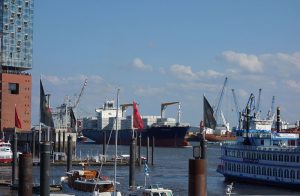 Hamburg is the third largest port in Europe, after Rotterdam and Antwerp. And just as Rotterdam and Antwerp have traditionally been river ports, so is Hamburg. But Hamburg is situated more than a hundred kilometers from the North Sea, on the tidal river Elbe. The Elbe rises in the Giant Mountains in the Czech Republic and is 1165 kilometers long. The disadvantage of Hamburg is that seagoing ships have to sail a long way over a winding and silting river before they reach their destination. Only at high tide can fully loaded ships enter the port, otherwise they will have to sail with less cargo. About 10,000 sea-going ships call at the port every year.
Hamburg is the third largest port in Europe, after Rotterdam and Antwerp. And just as Rotterdam and Antwerp have traditionally been river ports, so is Hamburg. But Hamburg is situated more than a hundred kilometers from the North Sea, on the tidal river Elbe. The Elbe rises in the Giant Mountains in the Czech Republic and is 1165 kilometers long. The disadvantage of Hamburg is that seagoing ships have to sail a long way over a winding and silting river before they reach their destination. Only at high tide can fully loaded ships enter the port, otherwise they will have to sail with less cargo. About 10,000 sea-going ships call at the port every year.
Hamburg has a history of about 1300 years. In the early eighth century, Saxon farmers settled where the rivers Alster, Bille and Elbe converged. They built a castle, the Hammaburg, which was regularly destroyed by Vikings in the centuries that followed. Churches began to be built of brick in the eleventh century. In 1189, Hamburg was granted city rights, on the basis of a questionable certificate from Emperor Friedrich Barbarossa.
Hamburg is located in a maritime, northern area where sailing has been going on for several millennia. In the fourth century BCE, the Greek Pythias from Marseilles sailed here in search of tin and amber – which usually reached the Greek and Roman empires through arduous inland roads. From the seventh century, groups of Vikings from Scandinavia invaded the North Sea coasts to steal and trade. In the meantime, a large, fragmented Frisian empire developed on the North Sea coast; the Frisians were farmers, sailors and traders at the same time.
In the twelfth century, the Hanseatic League emerged, a loose alliance of trading cities, which mainly traded in the North Sea and the Baltic Sea and along tributary rivers. About 200 ports and small trading places were involved. The word Hansa means group: it concerned groups of merchants from these places. They organized themselves into a network to be safe from piracy of Vikings, to achieve free trade and tax advantages in all these ports, to always look for new markets and to earn good money. The main Hanseatic city was first Lübeck, later Hamburg.
After the Spanish and Portuguese explorations and conquests in the fifteenth and sixteenth centuries, the Atlantic trade emerged. The Hanseatic League lost power. Hamburg imported products from Spanish, Portuguese, Dutch and British colonies via Western European ports, and became a wealthy trading port. In 1815 the free Hanseatic city of Hamburg became a member of the German Confederation, in 1871 it became part of the German Empire. Shipyards were established on the Elbe, ports of entry, warehouses, factories.
The First World War (1914-1918) and the subsequent world economic crisis impoverished Hamburg; half to three-quarters of the dockers lost their job. Desperate people chose Hitler’s fascism. In 1933, when Hitler was elected chancellor, 39% of the Hamburgers voted for the fascist NSDAP. The port concentrated on armaments: battleships, submarines, war industry. Hitler visited Hamburg numerous times to support the war effort. During World War II (1940-1945), Hamburg was bombed repeatedly by British bombers. The city and the harbor were in ruins.
The Allies, especially the United States, helped Hamburg and Germany recover after the war. Thus, the German Wirtschaftswunder took place, of which Hamburg was the driving force. The port grew and expanded. Old port areas, like many other port cities around the world, were useless and converted into ultra-modern residential areas. As a crowning glory to the reconstruction, a striking, glass, dancing concert hall was constructed in 2017, the Elbphilharmonie, built on brick warehouses.




